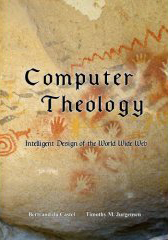PRESS
COMPUTER THEOLOGY |
||||
|
needed by the
body. As we alluded in Chapter 2, variations on this storage and retrieval
facility are likely the subjects of an ongoing appraisal through multi-level
natural selection. In the physical
environment, a significant premium is due to individuals of the primate species
that can react well to real and perceived threats. For the hominids, which do
not have a lot of inherent passive defensive or offensive mechanisms at their
disposal, the ability to respond quickly and decisively to stressful situations
is quite beneficial. Consequently, a foundational characteristic of the species
was recognized by Hans Selye as the fight or flight response to stress.
He published a 1946 paper describing the general
adaptation syndrome, of which the fight or flight response is essentially
the first stage, in the Journal of Clinical Endocrinology. When
presented with what may become a life or death situation, the human body
undergoes an almost instantaneous set of physiological changes that prepare it
either for battle or for a mad dash away from danger. In parallel with these
physiological responses, the mind forms an emotion modulated cognitive response
based on a contextual appraisal of the specific sensory stimuli, which answers
the rather profound question, “Do I run or do I fight?” The answer can well
determine the continuation of the person. Winston Churchill’s famous remark
comes to mind, “There’s nothing quite so exhilarating as to be shot at without
effect!” To engage the fight or flight response is to place a number of
exclamation points after the need to determine an action stimulus based on
sensory input. In response,
many of the body’s physiological changes are internal. Blood vessels constrict
in certain areas in order to essentially shut down non-essential organs such as
the kidneys and the digestive tract. Sensory awareness is heightened, the heart
and lungs kick into high gear, ready to support extremely increased physical
activity. Glucose stored in the liver is released into the blood stream to
provide an intermediate term energy boost, while epinephrine and endorphins are
released to first stimulate immediate physical capability and second to
diminish the body’s reaction to pain that may result from ongoing combat. These latter two
materials are actually neurotransmitters. They function at the synaptic
chemistry level of the body’s nervous system. In essence, they change the
impedance and amplification characteristics of the many different neuron
circuits through which sensory stimuli are received, the cognitive facilities
through which they are analyzed and the motor system through which the body’s
response is channeled. In situations of severe stress, we see and hear better,
we think faster and we become stronger and faster. We also tend to wet our
pants, a reaction that lightens us up a bit and might also, in our native
condition, surprise a predator that attacks us. In more modern combat, it’s a
small price to pay if bullets are evaded. In order to
acquire the necessary sustenance, evolution has molded the body to enhance the
process based on the environment. Within the animalia kingdom, only two phyla possess articulated skeletons that
provide shape and structural support for the individual members of their
various species: arthropoda,
including insects and lobsters, and chordata,
which includes all the vertebrate species. Articulation of the skeleton
indicates that the various structural components of the individual skeleton
meet at various points called joints. Joints allow different parts of the
skeleton to move relative to other points. This structure establishes a common
form for all the members of a specific species and it also provides for
mobility of the entities. Arthropods possess an exoskeleton. That is, the skeleton is comprised of a strong shell that forms the outer boundary of the individual. Muscles, or other mechanisms that induce movement, are present within this skeletal boundary. Typically, an exoskeleton provides protection along with the other characteristics provided by skeletons. From an evolutionary standpoint, exoskeletons tend to |
||||
|
||||
© Midori Press, LLC, 2008. All rights reserved for all countries. (Inquiries) The contents of ComputerTheology: Intelligent Design of the World Wide Web are presented for the sole purpose of on-line reading to allow the reader to determine whether to purchase the book. Reproduction and other derivative works are expressly forbidden without the written consent of Midori Press. Legal deposit with the US Library of Congress 1-33735636, 2007.
|
ComputerTheology Intelligent Design of the World Wide Web Bertrand du Castel and Timothy M. Jurgensen Midori Press, Austin Texas 1st Edition 2008 (468 pp) ISBN 0-9801821-1-5 |
Book available at Midori Press (regular) |
